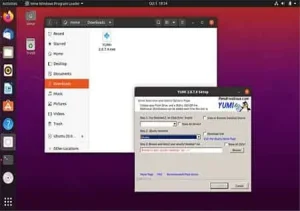Persistent Linux - What is it? After looking through some of the tutorials offered on Pen Drive Linux, you may be wondering what USB persistence means. So in the following segment, I will cover my understanding of persistence in relation to Linux, data storage and recovery on USB flash drives. In addition, I will try to explain some of the limitations of using a USB persistent overlay partition, image or other persistence file data storage structure.

Wikipedia definition: "Persistence - in computer science refers to the characteristic of data that outlives the execution of the program that created it. Without this capability, data only exists in RAM, and will be lost when the memory loses power, such as on computer shutdown."
What is a Persistent Linux Live USB?
A persistent Linux Live USB refers to a portable Linux operating system that you can run directly from a USB flash drive while retaining changes, installed applications, and user data across multiple reboots. Typically, a standard Live USB allows you to boot into a Linux environment from the USB drive, but any changes made during the session are not saved once you shut down or reboot the system.
In contrast, a Linux Live persistent USB includes a persistent file storage feature that enables you to save data, settings, and installed applications on the USB drive itself. This is achieved by creating a separate partition on the USB drive where the changes are stored. As a result, you can carry your personalized Linux environment with you on a USB stick and use it on different computers without losing your modifications.
The process of creating a Persistent Live Linux USB involves configuring the USB drive to recognize and use the persistent storage space. The exact steps can vary depending on the Linux distribution you are using. Some popular distributions that support persistence include Arch, Fedora, Ubuntu and Debian based distributions such as KALI Linux.
What does Persistence mean for USB Linux Users?
For USB Linux users, a Persistent Linux install is one that allows its user to save data changes back to the USB storage device instead of leaving the information in system RAM. This data can then be recovered and used again on subsequent boots, even when booting from different machines. Typically a separate Persistent storage space (persistent overlay) image or partition is used in conjunction with a compressed Live Linux OS.
Linux persistence feature advantages & disadvantages
There are several advantages and disadvantages to using a Linux Persistence feature for storage. Here's a breakdown of both:
Advantages of using persistent storage:
- More available storage space - Since the Live Linux Operating System (OS) is compressed with most persistent installs, the entire operating system takes up less space. Enabling operating systems that usually require gigabytes of space to be condensed into storage capacities less than 1GB in many cases.
- Less wear on the USB device - Since most of the operating system is loaded into system memory and only the changes are written back to the USB storage device, the read/write cycles decrease, prolonging your USB flash drives life.
- Independent Overlay - The overlay storage space used for persistent changes is independent of and separated from the OS, allowing users to backup or recover persistent changes on the fly without reinstalling and rebuilding an entire operating system. The operating system should still continue to function like a fresh install if the persistence feature is disabled.
- Portability - Bookmarks, settings, system preferences, customizations and file downloads can in most cases be stored and retrieved when booting from different or multiple machines.
Disadvantages of using persistent storage:
- Limited Protection - Persistent data is left unencrypted in most cases. If you lose your drive, someone could steal and use your data.
- Persistent data is uncompressed - Although the Live OS can be compressed, the persistent data is left uncompressed making it very easy to run out of storage space quickly.
- Some changes are not saved persistently - In some cases, further modification is required to enable things like graphical card settings and network card settings to be saved. In almost all cases, system wide kernel updates and upgrades will not work and could result in a broken boot.
*System and initrd updates appear to be working on recent Ubuntu and related remixes. See how to create an Ubuntu Persistent USB.
Using a Persistent Linux USB is advantageous for tasks such as system recovery, troubleshooting, or having a portable environment that you can use on various computers without leaving traces behind on the hard drive of the locally installed operating system.

